How to teach a dog to sit command?

Sit! Command is included in any basic dog training course. It seems that teaching a dog what it already knows how to do by nature is pointless. But the significance of this skill is very great. The team develops in the pet such important qualities as obedience, endurance and attentiveness. On the other hand, this can make life much easier for the owner, when it will be necessary to quickly calm down the playing dog.

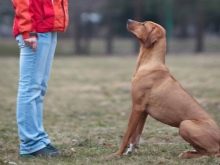

At what age can a puppy be trained?
Many dog breeders have a question about at what age the dog is able to perceive commands and clearly fulfill the requirements. Some postpone this process until a later period, while others try to teach the puppy various commands from almost one month of age.
Cynologists say that it is best to start the process of teaching the Sit command no later than three months of age.
At this time, the puppy is already quite capable of assimilating and fulfilling the requirements.

It should be noted that many breeders start training much earlier. And this brings positive results. By the time of the onset of strict training, the dog already understands what they want from it and how to react. However, do not forget that up to the age of 3 months, the entire training process should take place in a playful way. This will help develop your puppy's interest and love for the activity. If you act aggressively, then the dog will have a negative idea of all the activities, and the process will go much slower and more difficult.
Puppies are taught new commands using food. This is the most effective and pleasant way for them at this age. It is better to leave mechanical impact for later periods, when the dog's priority will be the praise of the owner.
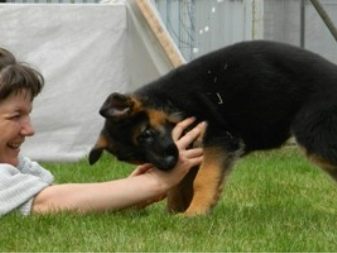

Learning methods
There are two main ways to teach your dog to sit at home. It is mechanical and powered by feed. In the first case, the owner himself shows the pet what he wants to achieve from him. By pressing on the lower back, he forces the dog to take a sitting position.
In the second case, only a voice command or a hand gesture is used. The generally accepted gesture is an arm bent at the elbow, pointing up, with an open palm. It may seem that the second method is more complicated.
But it is worth considering the fact that the dog always receives a reward in the form of a treat, and therefore gladly obeys the owner's request.
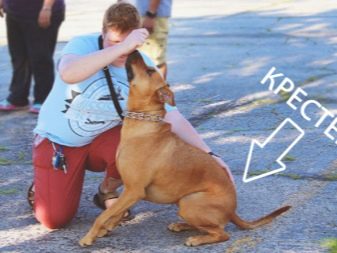
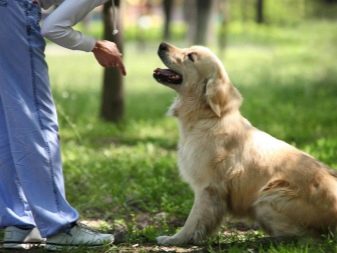
Both the first and the second method have their pros and cons. In addition, in many ways, the method of training depends on the temperament and breed of the dog. If you can apply both one and the other option to Labradors, then in training the Doberman it is better to use the option with complementary foods, since these dogs react negatively to physical impact.
There is also a third (combined) way of teaching a team. This is when the trainer himself seats the dog in the desired position by pressing on the sacrum, but at the same time does not forget to give sweets after execution. This option is often used in the early stages of training.
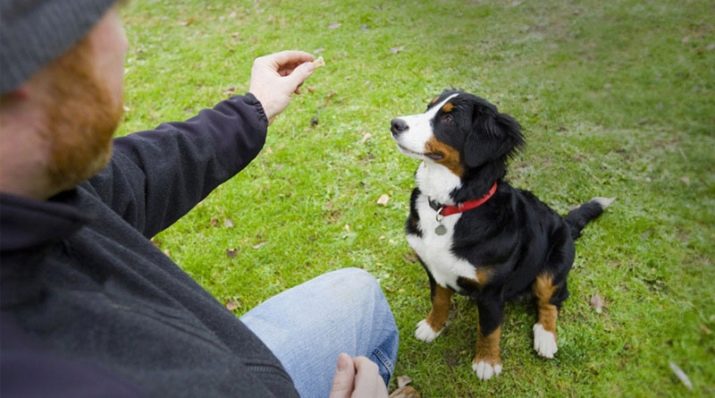
Sometimes even those dogs who already know a given command refuse to follow it. The reason for this may be active play with other animals, interest in a new place or object. You have to ensure that the pet clearly follows your voice commands, even at a distance from you. In this case, you can also resort to different methods.
For example, if you trained the dog with food, but at a distance he does not obey, you can approach the dog and again strictly pronounce the requirement. A strongly played dog can be calmed and seated with the palm of your hand.
Movements should be clear and confident, but not painful to the dog.
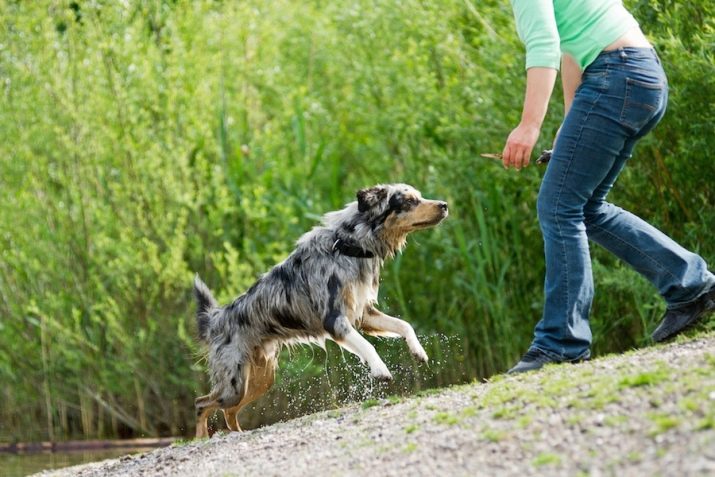
How to teach with feed
This method is suitable for both puppies and adult dogs. Its main advantage is that the trainer does not touch the dog when training and practicing new skills.
So that the dog more willingly observes commands and waits for a well-deserved reward, do not feed him before the start of the class. The best thing, if the last meal is 5-7 hours (depending on breed and age) before training.

So, here are the basic steps for conducting a lesson.
- First, call the dog over to you. This should be done in a calm, confident tone. You should not hear notes of aggression and irritation in it, but it is better to avoid special delight and joy in intonations.
- When the puppy approaches your call, stand so that it is near your left leg.
- Clench the treat in a fist and bring it to your pet's nose. At the same time, all attempts to snatch it out of your hands must be stopped.
- Holding your hand with the treat above the dog's head, gently wind it behind the head. She will invariably follow your movement and draw her head back. When the hand is far away, it will need to sit down so as not to lose sight of the food. This is the main goal of this exercise. At the same time, when you start to move your hand behind the withers of the dog, calmly and confidently repeat the command several times. When the goal is achieved, treat the pet with a hidden treat. You should also praise him. For many dogs, the owner's approval means much more than even the most beloved treat.
- To consolidate the result, repeat the command several times. In the future, gradually train your dog to do it without your participation (the hand must remain motionless). Reinforcing the skill will take time, but all efforts will be rewarded in the future.After all, having mastered and honed this command, you will be sure that under any conditions and external stimuli, the dog will unquestioningly carry it out.
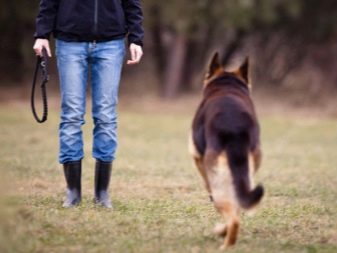
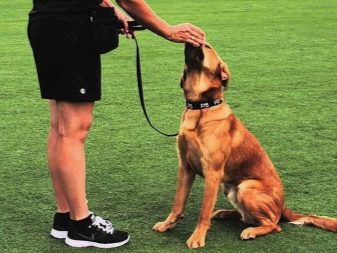
Mechanical training
In this case, the owner literally shows the dog what is required of him. Many people are afraid or do not accept this technique, thinking that in the future, without physical contact, the dog will not follow this or that command. This is not true. It is important to approach learning competently.
Physical impact or contact is allowed only at the time of training the dog. But you don't have to repeat this action over and over again. If you accompany the pressing on the dog's lower back with a command, after several trainings he should understand what is required of him.
In the future, the command will be given only by voice.
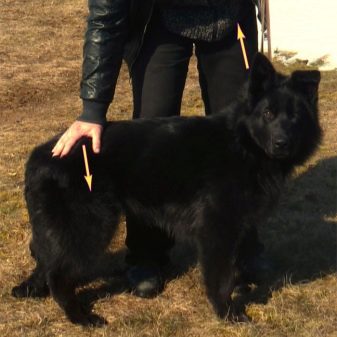

Call the dog to you. It is important that he is calm and not distracted by other objects.... Make eye contact with your pet and say the command calmly but clearly. At the same time, press on the lower back with your hand. Feeling this pressure, the dog will take the desired position. Praise your pet by saying encouraging words of support "Well done!" "Good girl", "Good."
You can also come up with your own praise clichés. At the same time, you should not select new epithets every time. 2-3 standard words will be enough. So the dog will better understand that he did everything right and the owner is pleased with her work.
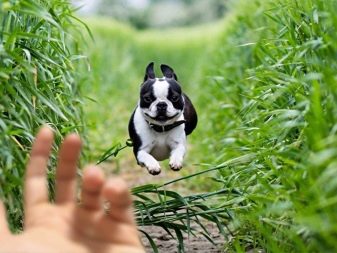
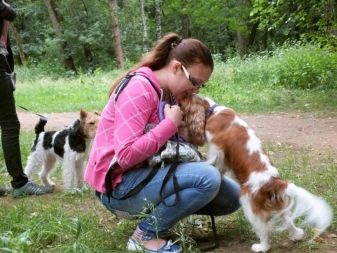
To wean the dog from physical contact when executing a command, gradually loosen the pressure. Later, a simple touch will suffice. But this is not the end goal either. The standard gesture for the “sit” command is the palm raised up. Therefore, in training, achieve exactly this result. The dog has already memorized the command and clearly knows what it needs to do. But sometimes it can wait for your touch. In this case, once again clearly and more strictly repeat “Sit!”, And wait for the dog to complete the task.
In the next steps, you can teach the dog to sit exactly at the left leg or follow the command according to your hand gesture.
Therefore, you should not stop only at the initial stage, when the dog has mastered the skill of sitting down when you press your hand.
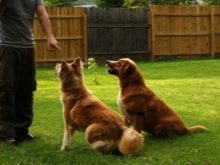
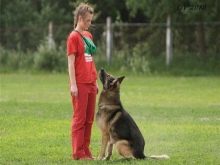
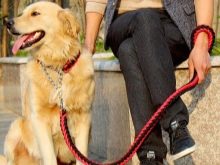
Major mistakes
When training, novice dog breeders often make mistakes. Subsequently, this can nullify all your efforts, or the desired result will not be achieved.
- Do not feed the treat immediately after the dog is in a sitting position. In this position, she should sit for at least 5-7 seconds. In the future, this time can be increased.
- The command "Sit" serves as a signal to start an action. But do not forget that a conditional signal is also required to complete the exercise. It could be praise or some other sign. This will ensure that after the order to "sit" the dog will remain in place even if you have stepped aside.
- The command should be given in an even calm voice. Do not use raised tones, screams, aggressive or harsh notes.
- Train your dog to give the command once. After pronouncing it, wait for the execution. Repeated repetition will lead to the fact that in the future the dog will not pay attention to her and wait until you yourself sit him down.
- With physical impact, the dog should not feel pain. In other words, your movements should be well coordinated, confident, but not uncomfortable for your pet. It will be perceived as an element of violence, not learning new things.
- Dogs love to learn new things. Therefore, do not stop at the simplest command execution. Make the task more difficult. To do this, you can train the dog to execute a command at a distance, by gesture, with a slight pull on the leash. Also make sure that the dog is sitting in the right position for the amount of time you need.
- Regular training. It is foolish to expect a positive result if you yourself do not devote enough time to the learning process. Moreover, one lesson should not last long. But consistency is of great importance.
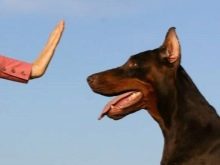


Helpful hints
The training should take place in a comfortable environment. If you practice outdoors, make sure the ground is dry. It is unacceptable to sit your pet on mud, puddles or just wet ground.
With any method of training it is worth reducing external influences (or the amount of delicacies). As a result, the dog must learn to follow the command without expecting food from you or pressing on its back. But praise should not be canceled.
It is important for your pet to hear and see your approval. This will stimulate him in the future.
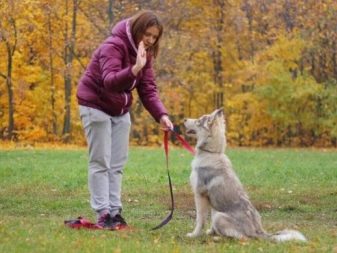
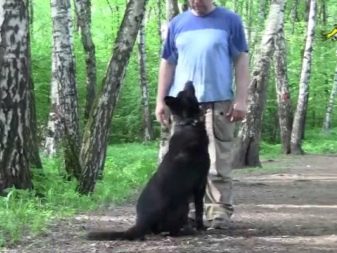
It is best to start training at an early age. But an adult dog can also be trained in the necessary commands. Only this will take more patience and time. But absolutely all dogs are trainable. The main thing is your desire and persistence.
See below for tips on teaching your dog the Sit Command.






































